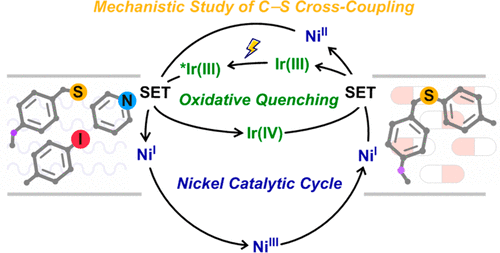当前位置:
X-MOL 学术
›
ACS Catal.
›
论文详情
Our official English website, www.x-mol.net, welcomes your
feedback! (Note: you will need to create a separate account there.)
How Does Iridium(III) Photocatalyst Regulate Nickel(II) Catalyst in Metallaphotoredox-Catalyzed C–S Cross-Coupling? Theoretical and Experimental Insights
ACS Catalysis ( IF 11.3 ) Pub Date : 2019-03-25 00:00:00 , DOI: 10.1021/acscatal.9b00375 Hang Ren 1 , Guang-Fu Li 1 , Bo Zhu 1 , Xiao-Dong Lv 1 , Li-Shuang Yao 2 , Xin-Long Wang 1 , Zhong-Min Su 1, 3, 4 , Wei Guan 1, 2
ACS Catalysis ( IF 11.3 ) Pub Date : 2019-03-25 00:00:00 , DOI: 10.1021/acscatal.9b00375 Hang Ren 1 , Guang-Fu Li 1 , Bo Zhu 1 , Xiao-Dong Lv 1 , Li-Shuang Yao 2 , Xin-Long Wang 1 , Zhong-Min Su 1, 3, 4 , Wei Guan 1, 2
Affiliation

|
Photoredox-mediated iridium/nickel dual catalysis has successfully triggered a series of traditionally challenging carbon–heteroatom cross-coupling reactions. However, detailed mechanisms, such as the catalytic cycles for dual catalysts and the role of base additive, remain controversy in these reactions. In this study, a highly chemoselective C–S cross-coupling of thiols with heteroaryl iodides has been investigated by density functional theory (DFT) calculations and emission quenching experiments. Interestingly, the oxidation state modulation mechanism merging oxidative quenching (IrIII–*IrIII–IrIV–IrIII) and nickel catalytic cycles (NiII–NiI–NiIII–NiI–NiII) is favorable. It is consisted of four major steps: pyridine mediated proton-coupled electron transfer, oxidative addition of heteroaryl iodides with Ni(I)–halide complex, reductive elimination, and single-electron transfer. In contrast, the radical mechanism initiated by reductive quenching of *IrIII with thiols is impractical, because oxidative addition or σ-bond metathesis from Ni(II)–thiolate intermediate is highly energy-demanding. This study will hopefully benefit the future understanding of such photoredox-mediated dual catalytic systems.
中文翻译:

铱(III)光催化剂如何调节金属光氧化还原催化的CS交叉偶联中的镍(II)催化剂?理论和实验见解
光氧化还原介导的铱/镍双重催化已成功引发了一系列传统上具有挑战性的碳-杂原子交叉偶联反应。然而,在这些反应中,诸如双催化剂的催化循环和碱添加剂的作用之类的详细机理仍存在争议。在这项研究中,已通过密度泛函理论(DFT)计算和发射猝灭实验研究了硫醇与杂芳基碘的高度化学选择性C–S交叉偶联。有趣的是,氧化态调节机制将氧化猝灭(Ir III – * Ir III –Ir IV –Ir III)与镍催化循环(Ni II –Ni I –Ni III –Ni)合并在一起I –Ni II)是有利的。它由四个主要步骤组成:吡啶介导的质子偶联电子转移,杂芳基碘化物与Ni(I)-卤化物络合物的氧化加成,还原消除和单电子转移。与此相反,由* Ir中还原淬火发起的自由基机理III与硫醇是不切实际的,因为氧化加成或σ -键置换选自Ni(II)-thiolate中间是高能苛求。这项研究有望有益于对这种光氧化还原介导的双催化系统的进一步理解。
更新日期:2019-03-25
中文翻译:

铱(III)光催化剂如何调节金属光氧化还原催化的CS交叉偶联中的镍(II)催化剂?理论和实验见解
光氧化还原介导的铱/镍双重催化已成功引发了一系列传统上具有挑战性的碳-杂原子交叉偶联反应。然而,在这些反应中,诸如双催化剂的催化循环和碱添加剂的作用之类的详细机理仍存在争议。在这项研究中,已通过密度泛函理论(DFT)计算和发射猝灭实验研究了硫醇与杂芳基碘的高度化学选择性C–S交叉偶联。有趣的是,氧化态调节机制将氧化猝灭(Ir III – * Ir III –Ir IV –Ir III)与镍催化循环(Ni II –Ni I –Ni III –Ni)合并在一起I –Ni II)是有利的。它由四个主要步骤组成:吡啶介导的质子偶联电子转移,杂芳基碘化物与Ni(I)-卤化物络合物的氧化加成,还原消除和单电子转移。与此相反,由* Ir中还原淬火发起的自由基机理III与硫醇是不切实际的,因为氧化加成或σ -键置换选自Ni(II)-thiolate中间是高能苛求。这项研究有望有益于对这种光氧化还原介导的双催化系统的进一步理解。































 京公网安备 11010802027423号
京公网安备 11010802027423号